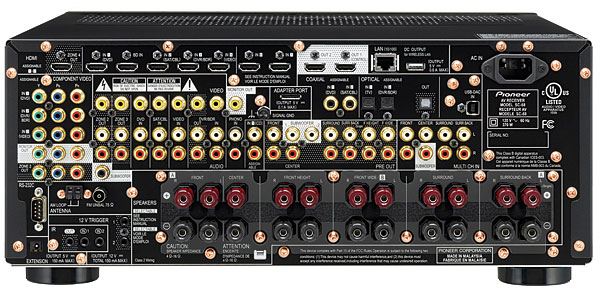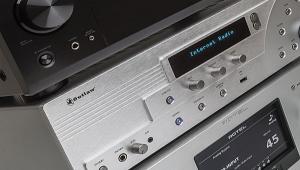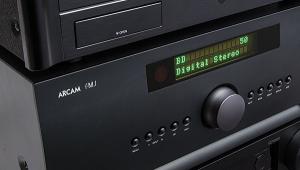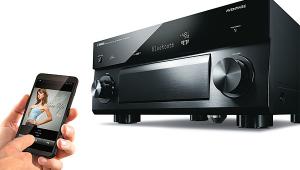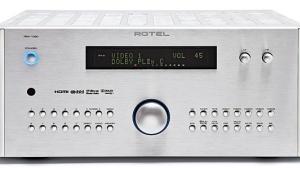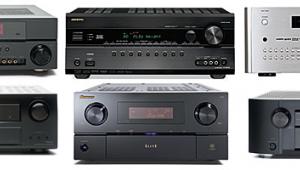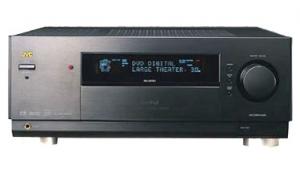Just the Facts: A/V Receiver Shopping & Tech Tips
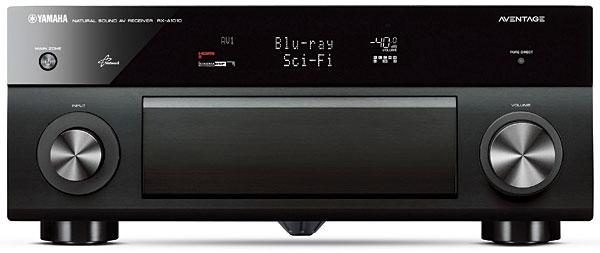
How much power do I need? Can I use my smartphone as a remote? Before you shop for that new receiver, here’s everything you need to know in a quick-read format. See our Top Receiver Picks.
Your power requirements will vary based on the efficiency of your speakers, the cubic volume of your room, and how loud you like to play your system.
Today's A/V receivers offer a mind-boggling array of features that can make it tricky to compare models. Here are a few of the more important features to check for.
Visit our How To Shop page for tips on shopping for Blu-ray Players, Speakers, Flat Panel TVs and more.
WHAT’S AN A/V RECEIVER?
An A/V receiver or “AVR” combines the following three components in one cabinet:
- Preamplifier: Provides preamplification of low-level source signals along with any equalization (tone control) and volume adjustments. Also provides audio and video switching among your sources so you can select each with the touch of a single button.
- Surround processor: Decodes the multichannel digital soundtracks on modern broadcasts, DVDs, and Blu-ray discs, sending each channel’s signal to its corresponding speaker location.
- Multichannel power amplifier: Amplifies each channel’s low-level signal to appropriate voltage for driving loudspeakers.
Your power requirements will vary based on the efficiency of your speakers, the cubic volume of your room, and how loud you like to play your system.
- Ratings of 75 to 100 watts per channel, RMS (continuous power) into an 8 ohm load with less than 0.1% distortion are not uncommon at all price levels, even with budget receivers costing $400 or less. These specifications are commonly given with only two channels driven to full output and the rest idle. Beware of amplifiers rated for “peak” power, which is primarily done to inflate the output rating for marketing purposes.
- An “all channels driven” specification in which five or seven channels are simultaneously driven to full output is a more meaningful test of the robustness of an amplifier. “Headroom,” or the reserve of power the amp can draw upon to respond to dynamic peaks in the content and the heavier demands of loud playback without distorting, is determined by the capabilities of the power supply. The best dedicated power amplifiers will fully maintain their rated power output with all channels driven and are often rated this way. AVRs typically show some reduction in output against their touted two-channel rating, but the best ones will show less drop-off. Read Home Theater A/V receiver reviews to see how an AVR fared on this torture test, but remember that not achieving full output with all channels driven doesn’t mean it’s a poor amplifier or that it won’t perform well. In real life, no program material calls for such draconian demands from an amplifer.
Today's A/V receivers offer a mind-boggling array of features that can make it tricky to compare models. Here are a few of the more important features to check for.
- Cross-conversion to HDMI output: Converts the video input signals from various analog legacy sources, such as a VCR or iPod dock, for output on the AVR’s HDMI monitor output. This simplifies hookup by allowing you to run just one HDMI cable to your HDTV display from the receiver and prevents you from having to switch TV inputs for different sources. You’ll find this in mid- to upper-level AVRs. If all of your sources use HDMI outputs (such as an HD cable box and a Blu-ray player), you won’t require this feature.
- Video upscaling and noise reduction: Mid- to high end AVRs have on-board video processors, often from respected 3rd-party suppliers like Marvell or Anchor Bay, that will also take the standard-definition video signals from your cable box, DVD player, or other legacy sources and convert their signal to an HDTV format for playback on your TV. They can’t create resolution that doesn’t exist, but they may do a better job of cleaning up and sharpening these programs than the scaler in your video display.
- Auto set-up and room correction: Mid to high-end AVRs have microphone-driven set-up routines that automatically detect speaker types and distances, and often have some kind of facility to automatically apply equalization to achieve more balanced sound across all the audible frequencies. Most receivers use the 3rd party room correction solutions from Audyssey; others, such as those from Pioneer and Yamaha, use proprietary solutions. These can dramatically improve sound quality depending on your room. Read our reviews to see which ones work well. If you opt for a receiver with Audyssey, avoid lower-end models with Audyssey 2EQ if possible, as it provides the lowest resolution of Audyssey’s four options, and provides no equalization to the bass frequencies where it is typically needed most.
- Surround modes: Decoding of high resolution Dolby TrueHD and DTS-HD Master Audio soundtracks from Blu-ray discs is essential, and all new AVRs will have this feature as well as being able to decode whatever soundtracks are found on your DVDs or come across your cable box.
- Dynamic compression and volume modes: Allows you to listen at lower volumes without sacrificing dialogue intelligibility or having to ride the volume control to tamp down dynamic peaks in the soundtrack. Look for the excellent 3rd party solutions from Audyssey, Dolby, and THX.
- Network and Internet services: Better receivers connect to your home network to allow direct streaming of Internet music services like Pandora, Spotify, Rhapsody, and various internet radio aggregators. You can also stream music and photo files from your computer or network hard drive.
- Remote apps: iOS and Android apps that turn your phone or tablet into a touchscreen remote control are becoming common, and can greatly simplify day-to-day operation of these complex devices. You can have a look before you buy by downloading the free app and checking it out in demo mode.
